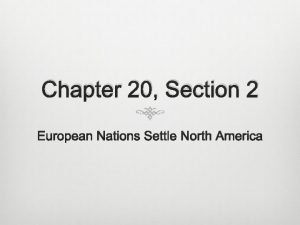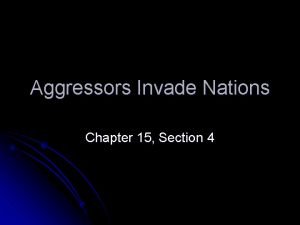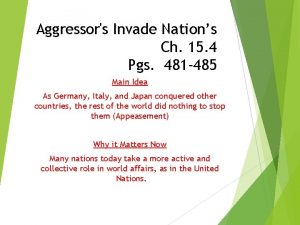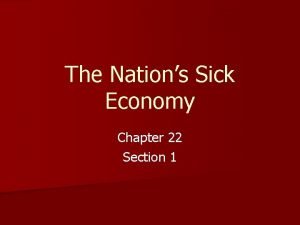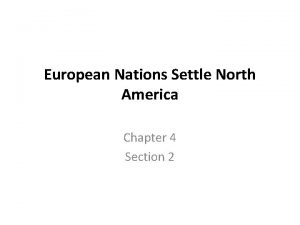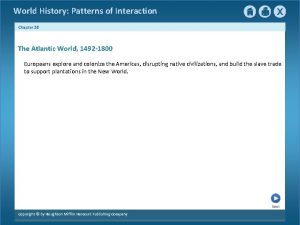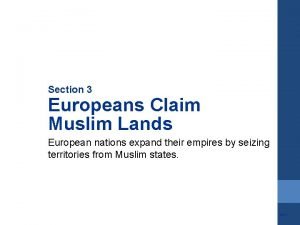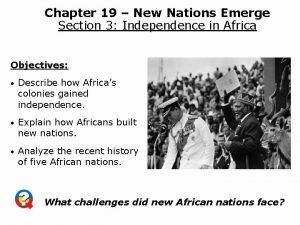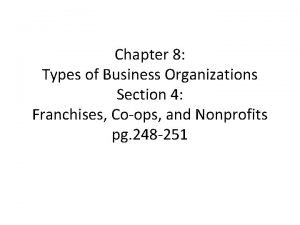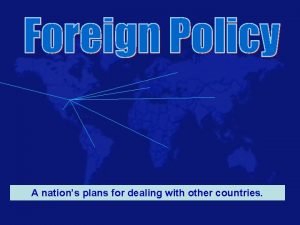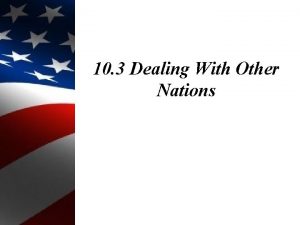Chapter 10 Section 2 Dealing with Other Nations













- Slides: 13

Chapter 10 Section 2 Dealing with Other Nations

Chapter 10 Section 2 Terms • cede – to give up. Example: Spain ceded Florida to the U. S. • Monroe Doctrine – 1823, Monroe stated that the U. S. would not allow European nations to create American colonies or interfere with Latin American nations. • self-government – the right of people to rule themselves independently • Province – a governmental division of a country, similar to a state Dealing with Other Nations

Chapter 10 Section 2 In the early 1800 s, Spain controlled a vast amount of territory in the Americas. However, Spain’s control in Florida was weak. Dealing with Other Nations

Chapter 10 Section 2 Fugitive slaves could easily cross from southern plantations into Florida and join the Seminole Nation. Southern plantations Fugitive slaves Together, they would often raid American settlements. Dealing with Other Nations Florida Seminoles

Chapter 10 Section 2 In 1817, the U. S. sent Andrew Jackson to recapture slaves that had escaped to Florida. Jackson went beyond his orders and seized two Spanish towns. Spain could not protect Florida, so it decided to give up the territory. Dealing with Other Nations Adams-Onís Treaty (1819) Spain ceded Florida to the United States.

Chapter 10 Section 2 Spain’s colonies in Latin America wanted independence. They were inspired by the revolutions in America and France. Dealing with Other Nations

Chapter 10 Section 2 Mexico led the way in 1810. Father Miguel Hidalgo organized an army that freed several provinces. Another revolution broke out in 1820. Spain could not end the fighting. Mexico became an independent monarchy in 1821, and by 1823 it became a federal republic. Dealing with Other Nations

Chapter 10 Section 2 Other colonies followed. By 1825, most parts of Latin America had thrown off European rule. This led to the creation of many new Latin American countries. The United States wanted to protect trade with Latin America. Dealing with Other Nations

Chapter 10 Section 2 Britain agreed with the U. S. and wanted to issue a joint statement. President James Monroe and Secretary of State John Quincy Adams did not want the U. S. to look like Britain’s junior partner. President Monroe decided to issue a statement. Dealing with Other Nations President James Monroe

Chapter 10 Section 2 In 1823, Monroe stated the Monroe Doctrine. The Monroe Doctrine The U. S. would not allow European nations to create American colonies or interfere with Latin American nations. Dealing with Other Nations

Chapter 10 Section 2 At first, the United States relied on Britain’s navy to enforce the Monroe Doctrine. As U. S. power grew, the Monroe Doctrine boosted U. S. influence in Latin Americans were relieved that their southern borders were secure from European powers. Dealing with Other Nations

Chapter 10 Section 2 Canada was also a British colony. In 1791, it was divided into two parts. Upper Canada Lower Canada In 1837, both parts rebelled against British rule. Britain ended the rebellions and unified the two parts in 1841. Canadians also received more powers of selfgovernment. Dealing with Other Nations

Chapter 10 Section 2 Tension between the U. S. and Canada was high after the War of 1812. The U. S. and Britain settled border disputes with Canada from 1818 to 1846. Eventually, the U. S. and Canada established excellent relations. Their relations remain strong to this day. Dealing with Other Nations
 Section 2 dealing with other nations
Section 2 dealing with other nations European nations settle north america chapter 20 section 2
European nations settle north america chapter 20 section 2 15.4 guided reading aggressors invade nations answers
15.4 guided reading aggressors invade nations answers Aggressors invade nations chapter 31 section 4
Aggressors invade nations chapter 31 section 4 Chapter 15 section 4 aggressors invade nations
Chapter 15 section 4 aggressors invade nations Chapter 22 section 1 the nations sick economy
Chapter 22 section 1 the nations sick economy European nations settle north america
European nations settle north america World history chapter 20 activity 6
World history chapter 20 activity 6 Chapter 20 section 2 european nations settle north america
Chapter 20 section 2 european nations settle north america Chapter 20 section 2 european nations settle north america
Chapter 20 section 2 european nations settle north america Chapter 5 lesson 1 dealing with anxiety and depression
Chapter 5 lesson 1 dealing with anxiety and depression Chapter 5 lesson 1 dealing with anxiety and depression
Chapter 5 lesson 1 dealing with anxiety and depression New nations emerge section 2 quiz
New nations emerge section 2 quiz Section 4 other organizations
Section 4 other organizations

